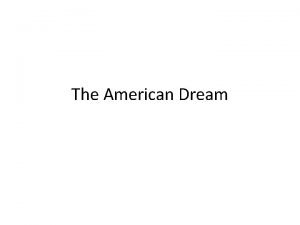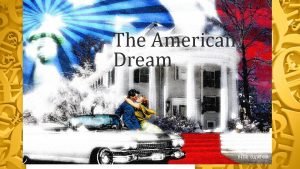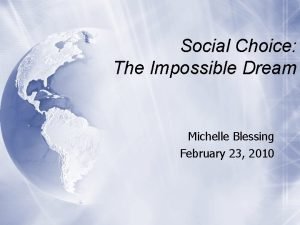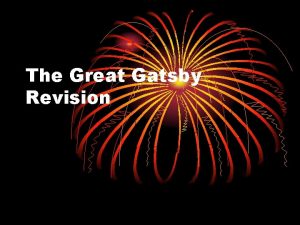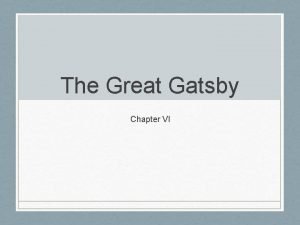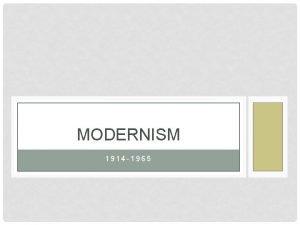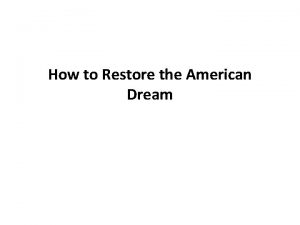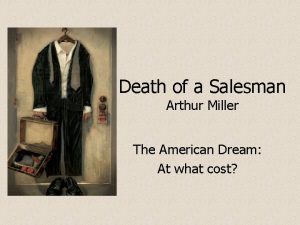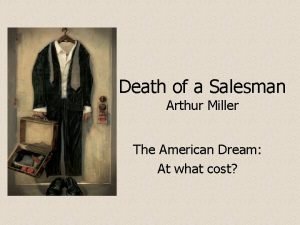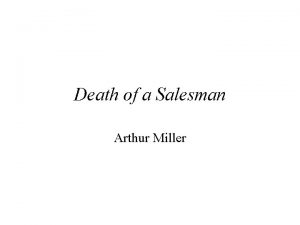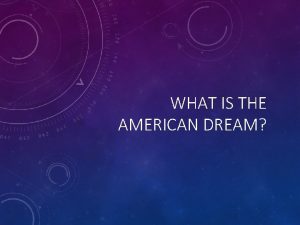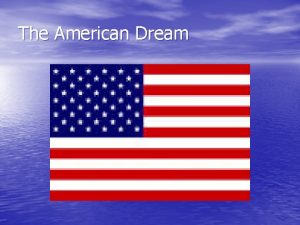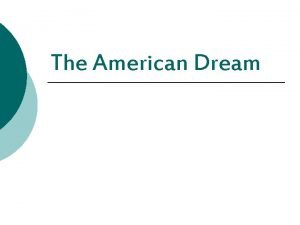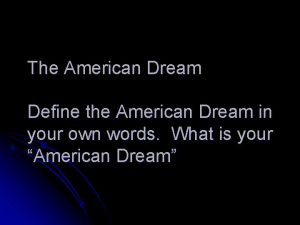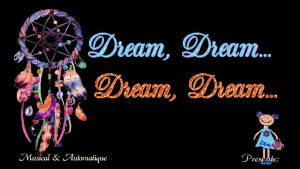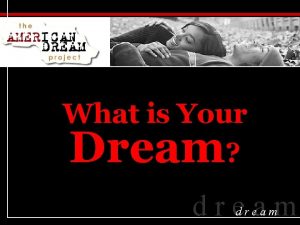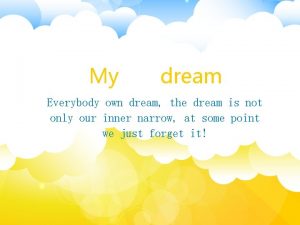THE AMERICAN DREAM MAIN DEFINITION The American Dream
















- Slides: 16

THE AMERICAN DREAM

MAIN DEFINITION • The American Dream is a national ethos of the United States, the set of ideals (Democracy, Rights, Liberty, Opportunity, and Equality) in which freedom includes the opportunity for prosperity and success, and an upward social mobility for the family and children, achieved through hard work in a society with few barriers.

FOUR DREAMS OF CONSUMERISM The new consumer culture addressed. The first was the "Dream of Abundance" offering material goods to all Americans, making them proud to be the richest society on earth. The second was the "Dream of a Democracy of Goods" whereby everyone had access to the same products regardless thereby challenging the aristocratic norms of the rest of the world.

FOUR DREAMS OF CONSUMERISM • The "Dream of Freedom of Choice" with its ever expanding variety of good allowed people to fashion their own particular lifestyle. Finally, the "Dream of Novelty", in which ever-changing fashions, new models, and unexpected new products broadened the consumer experience in terms of purchasing skills and awareness of the market, and challenged the conservatism of traditional society and culture, and even politics.

THE AD IN THE 1920 S -Fame - Money - Music - Party - Girls with provocative clothes - Alcohol, drugs… - FUN

REALITY OF THE AD IN THE 1920 S - Power = Money - Men were more powerfull than women - Society was controlled by the rich people - People wanted to be famous to get economical power - Much people were poor - Forbidden things were sold in the black market - Lot of people died because of drugs, alcohol, tobacco

PERIOD OF CHANGE q Although the AD was not what people think, it was a time of social and economic change. • Black people began to be accepted and seen as equal to us • There was a change in the fashion industry • New styles of music appeared, like jazz • Women started to had more power • Factories started to grow and created more jobs

THE AD NOWADAYS This dream translates into the belief that to be happy, one must have a large, single-family home in a good neighborhood, two cars per family, and substantial savings. In that dream, every new arrival to America can become wealthy and prosperous if only he or she works hard enough.

REALITY OF THE AD NOWADAYS -Tens of millions in America cannot work and make their dreams come true simply because they cannot get a job. - The healthcare and welfare systems are so unequal that they only perpetuate the socioeconomic inequalities. - Only few people realize The American Dream while the rest continue to struggle to avert poverty. q But the biggest surprise about The American Dream is not that only a few make that dream come true. Rather, it is the fact that even those who do succeed are not any happier!

RELATION WITH THE GREAT GATSBY • You can see what happened to it during the 1920 s. • The values have totally changed, instead of striving for equality, they just want to get as rich as they could get. • He shows that people are not yet treated equally and that social discrimination exists • Most of the people appearing in The Great Gatsby are full of hope

GATSBY • • • Gatsby who is hoping to win Daisy back. He has an “extraordinary gift of hope” He sacrifices himself to fulfill his dream. He struggles to get into the upper class. His dream fails completely, and his life finds an abrupt end.

NICK CARRAWAY • • • It is a pragmatic man, who comes from the Middle-West He does not share the American dream He wants to be himself, tolerant, objective and reliable. The money of the upper class is just a tiny bit of his dream He says of himself “ I am one of the few honest people that I have ever known”

DAISY • She lives her American Dream with Tom as her husband, who has a lot of money. • She does not have any long term aims in her life. • Having that kind luxury around her, she lives for the moment, and does not think about the next one.

TOM BUCHANAN • He was born into his American Dream. • He never had to work in his life, and got all his money from his parents. • Since everything is perfect he does not want any changes. • Losing Daisy would be a major change in his dream because he sees her as one of his possessions.

GEORGE WILSON • Wilson’s dream is to earn enough money to move away with his wife and to start a new life some place beautiful. • His dream can just become true with the help of Tom. • Wilson does not realize that Tom does not want to help him at all. • His dream fails, when his wife is killed.

MYRTLE WILSON • She wants to become a girl of the upper clas • Having an affair with Tom, she acts as if she already belonged among those rich people • Tom is her key to the upper class and she would do everything for him • She hates Daisy, because Daisy is standing in her way, for her marriage with Tom.
 Definition american dream
Definition american dream Aspects of american dream
Aspects of american dream American dream definition
American dream definition To dream the impossible dream poem
To dream the impossible dream poem Poetry symbolism
Poetry symbolism Willfuture
Willfuture Sample paragraph with main idea and supporting details
Sample paragraph with main idea and supporting details Void main int main
Void main int main Setting of great gatsby
Setting of great gatsby The great gatsby
The great gatsby Modernism and the american dream
Modernism and the american dream How to restore the american dream by fareed zakaria
How to restore the american dream by fareed zakaria Death of a salesman american dream theme
Death of a salesman american dream theme What is the american dream in death of a salesman
What is the american dream in death of a salesman What is the theme of death of a salesman
What is the theme of death of a salesman Theme in death of a salesman
Theme in death of a salesman All my sons theme
All my sons theme

